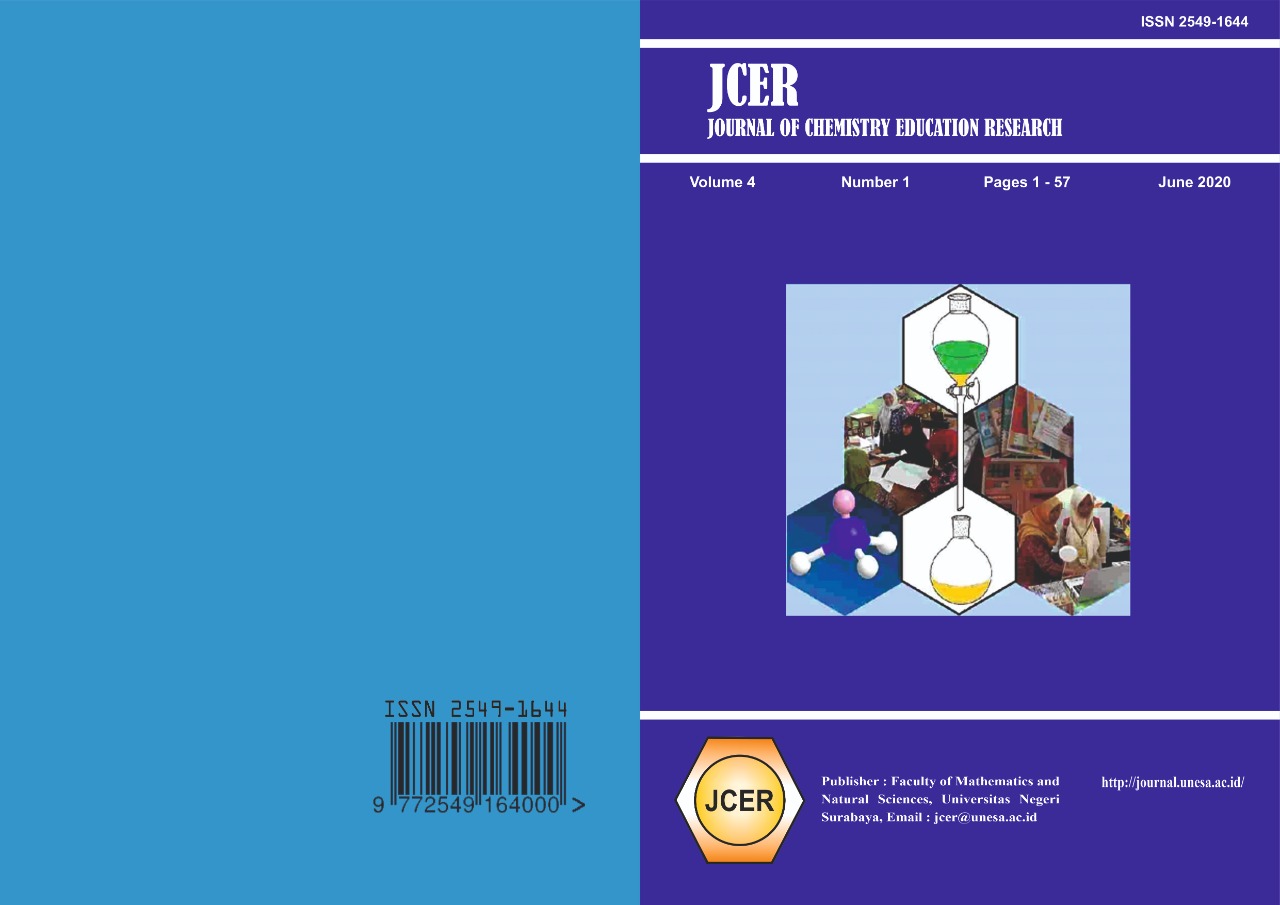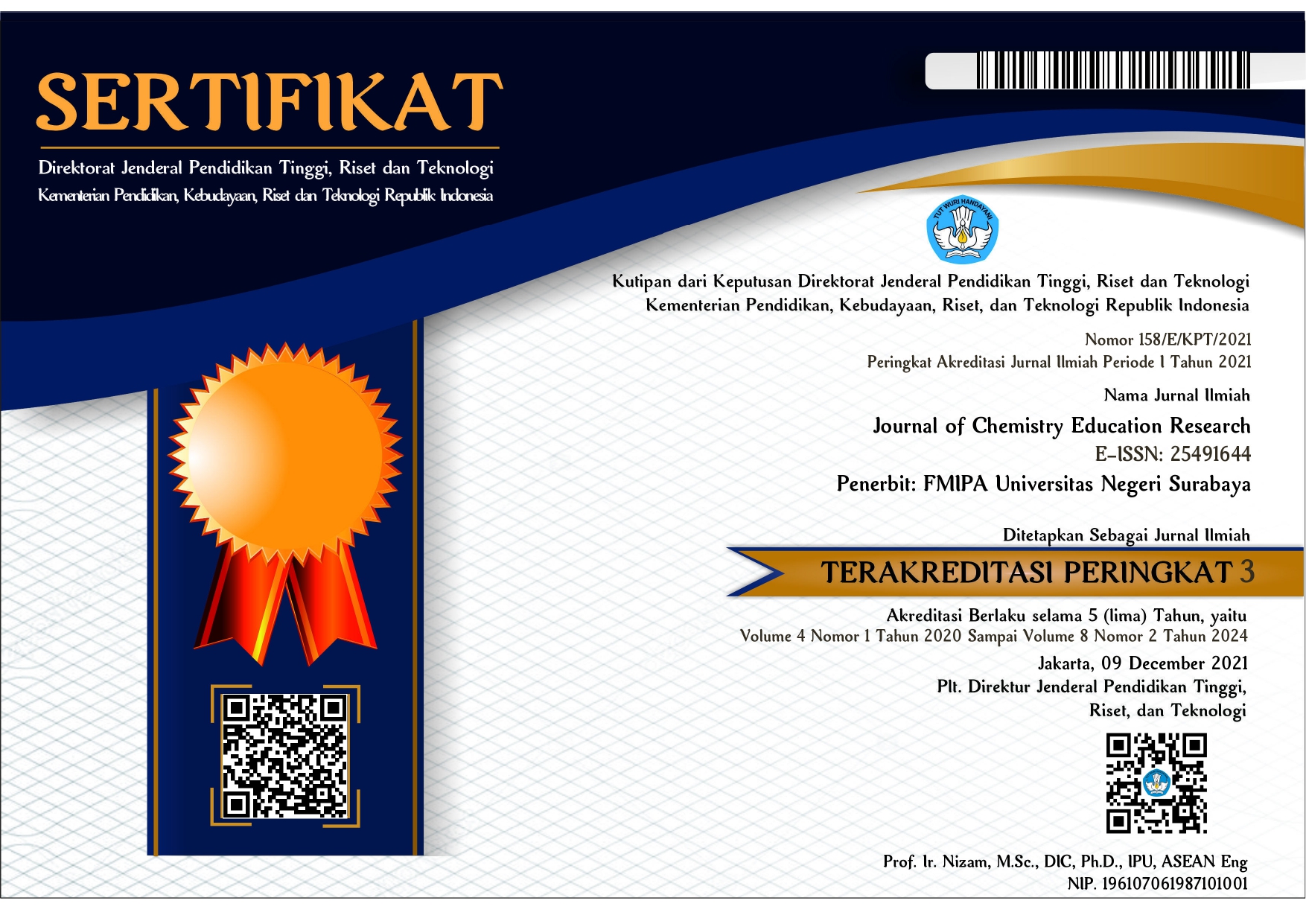Development of a Four-Tier Instrument of Acid-Base properties of salt Solution
DOI:
https://doi.org/10.26740/jcer.v4n1.p51-57Keywords:
four-tier instrument, salt hydrolysis, acid-base properties of salt solution, students’ understandingAbstract
Many chemistry teachers claimed that identifying students' understanding genuinely is challenging due to the limited time available, and the overload works faced. Therefore, constructing an efficient and valid instrument to overcome this difficulty is a must. This study is a part of the big project to produce a robust four-tier instrument to identify students' conception of acid-base properties of salt solution (FTI-ABPS2). The project involved six groups of researchers, and each group carried out the study in 6 different participant groups and schools. This paper outlines the development and validation of a four-tier instrument of Acid-Base properties of salt Solution involving public secondary school students in Malang Regency. The instrument was constructed using the procedure as carried out by Habiddin & Page (2019). Twenty-eight questions were constructed for the instrument. The results show that the instrument is valid and reliable to be implemented further. In-depth analysis regarding content validity, as well as the empirical validity of the instrument in light with the characteristic of chemical concepts (acid-base properties of salt solution in particular), is also discussed.References
[1] Allen, M. J., &Yen, W. M. 2002. Introduction to Measurement Theory. Waveland Press, Inc.
[2] Anonymous. n.d.. Item Analysis of Classroom Tests: Aims and Simplified Procedures. http://www.udel.edu/educ/gottfredson/451/unit9-guidance.htm
[3] Arikunto, S. 1993. Dasar-Dasar Evaluasi Pendidikan. PT Bumi Aksara.
[4] Caleon, I., & Subramaniam, R. 2010a. Development and Application of a Three-Tier Diagnostic Test to Assess Secondary Students Understanding of Waves. International Journal of Science Education, 32(7), 939961.
[5[ Caleon, I., & Subramaniam, R. 2010b. Do Students Know What They Know and What They Dont Know? Using a Four-Tier Diagnostic Test to Assess the Nature of Students Alternative Conceptions. Research in Science Education, 40(3), 313337.
[6] DiBattista, D., & Kurzawa, L. 2011. Examination of the Quality of Multiple-choice Items on Classroom Tests. Canadian Journal for the Scholarship of Teaching and Learning: CJSoTL, 2(2).
[7] Febriani, G., Marfuah, S., & Joharmawan, R. 2018. Identifikasi Konsep Sukar, Kesalahan Konsep, dan Faktor-Faktor Penyebab Kesulitan Belajar Hidrolisis Garam Siswa Salah Satu SMA Blitar. J-PEK (Jurnal Pembelajaran Kimia), 3(2), 3543.
[8] Habiddin, H., & Page, E. M. 2019. Development and Validation of a Four-Tier Diagnostic Instrument for Chemical Kinetics (FTDICK). Indonesian Journal of Chemistry, 19(3), 720. https://doi.org/10.22146/ijc.39218
[9] Husniah, I., Habiddin, H., Suaidy, M., & Nuryono, N. 2019. Validating an instrument to investigate students conception of Salt hydrolysis. Journal of Disruptive Learning Innovation (JODLI), 1(1), 16.
[10] Kimberlin, C. L., & Winterstein, A. G. 2008. Validity and reliability of measurement instruments used in research. Am J Health Syst Pharm, 65(23), 22762284.
[11] Kirbulut, Z. D. 2014. Using Three-Tier Diagnostic Test to Assess Students Misconceptions of States of Matter. EURASIA Journal of Mathematics, Science & Technology Education, 10(5), 509521.
[12] Milenković, D. D., Hrin, T. N., Segedinac, M. D., & Horvat, S. 2016. Development of a Three-Tier Test as a Valid Diagnostic Tool for Identification of Misconceptions Related to Carbohydrates. Journal of Chemical Education, 93(9), 15141520.
[13] Nimmermark, A., Ohrstrom, L., Martensson, J., & Davidowitz, B. 2016. Teaching of chemical bonding: a study of Swedish and South African students conceptions of bonding. Chemistry Education Research and Practice.
[14] Nyachwaya, J. M. 2016. General chemistry students conceptual understanding and language fluency: acidbase neutralization and conductometry. Chemistry Education Research and Practice, 17(3), 509522.
[15] Pesman, H., & Eryilmaz, A. 2010. Development of a Three-Tier Test to Assess Misconceptions About Simple Electric Circuits. Journal of Educational Research, 103(3), 208222.
[16] Romine, W. L., Todd, A. N., & Clark, T. B. 2016. How Do Undergraduate Students Conceptualize AcidBase Chemistry? Measurement of a Concept Progression. Science Education, 100(6), 11501183.
[17] Sreenivasulu, B., & Subramaniam, R. 2014. Exploring Undergraduates Understanding of Transition Metals Chemistry with the use of Cognitive and Confidence Measures. Research in Science Education, 44(6), 801828.
[18] Yang, D. C., & Lin, Y. C. 2015. Assessing 10- to 11-year-old childrens performance and misconceptions in number sense using a four-tier diagnostic test. Educational Research.
[2] Anonymous. n.d.. Item Analysis of Classroom Tests: Aims and Simplified Procedures. http://www.udel.edu/educ/gottfredson/451/unit9-guidance.htm
[3] Arikunto, S. 1993. Dasar-Dasar Evaluasi Pendidikan. PT Bumi Aksara.
[4] Caleon, I., & Subramaniam, R. 2010a. Development and Application of a Three-Tier Diagnostic Test to Assess Secondary Students Understanding of Waves. International Journal of Science Education, 32(7), 939961.
[5[ Caleon, I., & Subramaniam, R. 2010b. Do Students Know What They Know and What They Dont Know? Using a Four-Tier Diagnostic Test to Assess the Nature of Students Alternative Conceptions. Research in Science Education, 40(3), 313337.
[6] DiBattista, D., & Kurzawa, L. 2011. Examination of the Quality of Multiple-choice Items on Classroom Tests. Canadian Journal for the Scholarship of Teaching and Learning: CJSoTL, 2(2).
[7] Febriani, G., Marfuah, S., & Joharmawan, R. 2018. Identifikasi Konsep Sukar, Kesalahan Konsep, dan Faktor-Faktor Penyebab Kesulitan Belajar Hidrolisis Garam Siswa Salah Satu SMA Blitar. J-PEK (Jurnal Pembelajaran Kimia), 3(2), 3543.
[8] Habiddin, H., & Page, E. M. 2019. Development and Validation of a Four-Tier Diagnostic Instrument for Chemical Kinetics (FTDICK). Indonesian Journal of Chemistry, 19(3), 720. https://doi.org/10.22146/ijc.39218
[9] Husniah, I., Habiddin, H., Suaidy, M., & Nuryono, N. 2019. Validating an instrument to investigate students conception of Salt hydrolysis. Journal of Disruptive Learning Innovation (JODLI), 1(1), 16.
[10] Kimberlin, C. L., & Winterstein, A. G. 2008. Validity and reliability of measurement instruments used in research. Am J Health Syst Pharm, 65(23), 22762284.
[11] Kirbulut, Z. D. 2014. Using Three-Tier Diagnostic Test to Assess Students Misconceptions of States of Matter. EURASIA Journal of Mathematics, Science & Technology Education, 10(5), 509521.
[12] Milenković, D. D., Hrin, T. N., Segedinac, M. D., & Horvat, S. 2016. Development of a Three-Tier Test as a Valid Diagnostic Tool for Identification of Misconceptions Related to Carbohydrates. Journal of Chemical Education, 93(9), 15141520.
[13] Nimmermark, A., Ohrstrom, L., Martensson, J., & Davidowitz, B. 2016. Teaching of chemical bonding: a study of Swedish and South African students conceptions of bonding. Chemistry Education Research and Practice.
[14] Nyachwaya, J. M. 2016. General chemistry students conceptual understanding and language fluency: acidbase neutralization and conductometry. Chemistry Education Research and Practice, 17(3), 509522.
[15] Pesman, H., & Eryilmaz, A. 2010. Development of a Three-Tier Test to Assess Misconceptions About Simple Electric Circuits. Journal of Educational Research, 103(3), 208222.
[16] Romine, W. L., Todd, A. N., & Clark, T. B. 2016. How Do Undergraduate Students Conceptualize AcidBase Chemistry? Measurement of a Concept Progression. Science Education, 100(6), 11501183.
[17] Sreenivasulu, B., & Subramaniam, R. 2014. Exploring Undergraduates Understanding of Transition Metals Chemistry with the use of Cognitive and Confidence Measures. Research in Science Education, 44(6), 801828.
[18] Yang, D. C., & Lin, Y. C. 2015. Assessing 10- to 11-year-old childrens performance and misconceptions in number sense using a four-tier diagnostic test. Educational Research.
Downloads
Published
2020-06-18
Issue
Section
Articles
License
Authors who publish with this journal agree to the following terms:
- Authors retain copyright and grant the journal right of first publication with the work simultaneously licensed under a Creative Commons Attribution License that allows others to share the work with an acknowledgement of the work's authorship and initial publication in this journal.
- Authors are able to enter into separate, additional contractual arrangements for the non-exclusive distribution of the journal's published version of the work (e.g., post it to an institutional repository or publish it in a book), with an acknowledgement of its initial publication in this journal.
 Abstract views: 2016
,
Abstract views: 2016
, PDF Downloads: 715
PDF Downloads: 715



